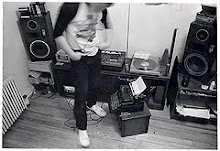The TG-33 is a descendant of Yamaha's very successful FM synthesizers of the 1980s, notably the DX7, cross-bred with sample playback technology. Each patch was made up of four sounds, some FM, some sample based — with the added magic of "vector control." The joystick on the left was used to mix these sounds over time, or within the patch. Much like Korg's popular Wavestation synth, the sound of a patch could flow from one distinct timbre to another. That movement could be saved within the patch or controlled in real time. Very cool.
It was pretty cheap, but the polyphony was less than they claimed, because each patch could use up to 4 voices of that polyphonym. It was easy to use up all your polyphony in just a few patches. But the voices where allocated dynamically. You could set up 16 midi channels, each with a different sound, and have them all available in a performance for sequencing or live performance, without needing to switch patches.
Despite the fact that the sample resolution was on the low side, quality-wise, 12 bit, I think, in the mix the sounds were pretty convincing. Alone, though, the patches could sound a bit thin.
This machine was best for creating sweeping atmospheres, a combination of the vector movement and the ample sound choices, but the thing had drums and bass guitars and everything you'd need to sequence songs.
Which is just what I used this for back in the days before computers made any sounds themselves. My Mac IIci ran Cubase, sequencing midi that this thing played back. The whole thing worked pretty well, it was easy to use, and pretty fun at that.
A bit of a relic now, but the vector joystick seems to have been an prescient ancestor to today's many midi controllers that musicians an DJs seem to love for mangling audio on the fly.
You can hear the factory demo here:
Sunday, February 28, 2010
Wednesday, February 10, 2010
Roland SH-32

This thing is an odd hybrid of desktop synthesizer, arpeggiator and groovebox. Yes, it had sort of an identity crisis– not exactly a synth, not exactly a groovebox or sequencer or drumbox. The arpeggiator is not easy to figure out, nor any of it, for that matter.
It does have lots on hands-on envelope sliders and knobs to tweak, and those are your basic ADSR controls, though aside from that, I remember a sense of always being lost in this thing, even when it was making a cool noise. Like a beautiful screwdriver that seems to need to be turned in a different direction every time you picked it up – I literally had a hard time getting a handle on the SH-32. The grovebox/drumbox functions were the hardesst to wrap ones head around.
Maybe the SH-32 was trying to hard to be too much? Or maybe it was a lot, but just packed into too tight a space. I don't know. But it sounded great. I'd recommend it for the sound quality and the hands-on tweakability of the synth part of it alone.
You can buy this on ebay for 200. You get yourself a great synth, and a lot more (if you have time on your hands).
Subscribe to:
Posts (Atom)

